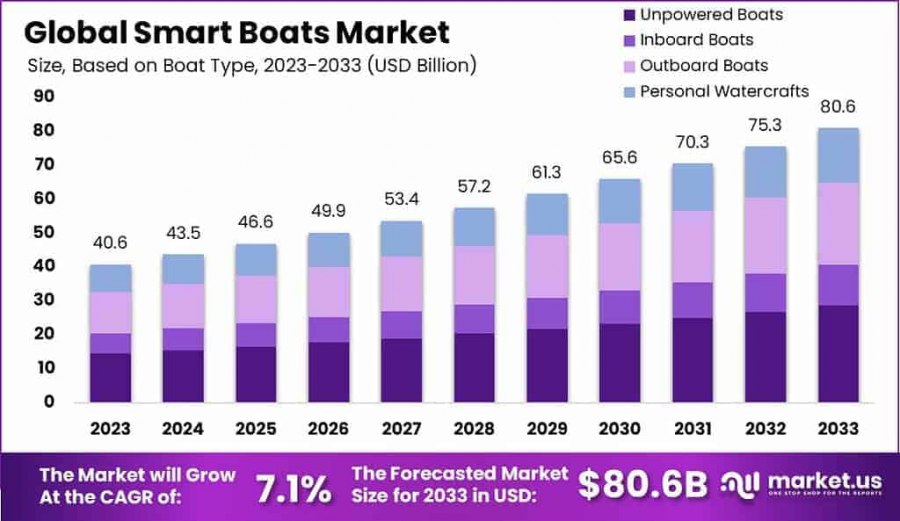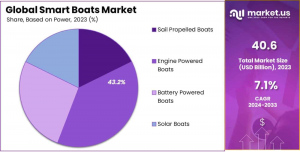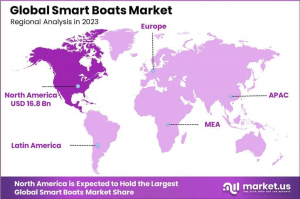
Smart Boats Market reach USD 80.6 Billion by 2033
Smart Boats Market is expected to be worth around USD 80.6 billion by 2033, up from USD 40.6 billion in 2023, growing at a CAGR of 7.1%.
NEW YORK, NY, UNITED STATES, January 23, 2025 /EINPresswire.com/ -- Market Overview
The Global Smart Boats Market is expected to be worth around USD 80.6 billion by 2033, up from USD 40.6 billion in 2023, growing at a CAGR of 7.1% during the forecast period from 2024 to 2033.
The Smart Boats market refers to the integration of advanced technologies, such as IoT, AI, and automation, into recreational and commercial vessels. These boats are equipped with sensors, data analytics tools, and autonomous features that enhance safety, efficiency, and user experience.
Smart Boats are designed to improve navigation, reduce fuel consumption, and enable remote operation, which is increasingly in demand within the maritime industry. This market is experiencing a rapid evolution driven by technological innovations and the growing need for sustainability in marine transportation.
The Smart Boats market is poised for substantial growth over the next decade, fueled by advancements in automation and smart technologies. As the maritime industry moves towards increased safety and reduced environmental impact, the demand for smart, energy-efficient boats is expected to surge. Governments around the world are also backing this transition with investments in green technologies, creating significant opportunities for innovation.
Policies promoting eco-friendly marine solutions, alongside incentives for the development of autonomous boats, are expected to further stimulate the market. However, regulatory frameworks for autonomous and connected boats must evolve to ensure safe integration into both domestic and international waters.
For both new entrants and established players in the Smart Boats market, this report offers valuable insights into market dynamics, emerging trends, and competitive strategies. New players can leverage opportunities in the growing demand for sustainable maritime solutions and capitalize on the push for autonomous vessels.
Existing players, on the other hand, can use this report to assess their current market position and identify areas for investment in innovation, technology partnerships, or regional expansions. Understanding these insights will enable strategic decision-making to enhance market share and long-term business growth.
Curious About Market Trends? Request Your Complimentary Sample Report Today: https://market.us/report/smart-boats-market/free-sample/
Key Takeaway
-The Global Smart Boats Market is expected to be worth around USD 80.6 billion by 2033, up from USD 40.6 billion in 2023, growing at a CAGR of 7.1% during the forecast period from 2024 to 2033.
-In 2023, Unpowered Boats held a dominant market position in the Based on Boat Type segment of the Smart Boats Market, with a 35.6% share.
-In 2023, Engine Powered Boats held a dominant market position in the Based on Power segment of the Smart Boats Market, with a 43.2% share.
-In 2023, Wood held a dominant market position in the Based on Raw Material segment of the Smart Boats Market, with a 32.3% share.
-In 2023, Water Sports held a dominant market position in the Based on Application segment of the Smart Boats Market, with a 41.3% share.
-North America dominated a 41.5% market share in 2023 and held USD 16.8 Billion in revenue from the Smart Boats Market.
Use Cases
1.Recreational Boating: Smart boats with integrated GPS, navigation systems, and entertainment options are revolutionizing recreational boating. They provide an enhanced experience by offering easy-to-use tech for navigation, safety, and leisure.
2. Fishing Industry: Smart boats equipped with sonar and real-time tracking systems are increasingly being used in the fishing industry. These technologies help fishermen locate fish more effectively, track weather conditions, and enhance their productivity.
3. Tourism and Leisure: Tourist operators use smart boats for guided tours, offering tourists real-time information about landmarks, wildlife, and the environment. Smart systems onboard improve the overall customer experience.
4. Search and Rescue Operations: Smart boats are used in emergency response scenarios due to their advanced sensors, communication systems, and automation features. These boats can navigate through challenging environments and assist in rescue missions with greater efficiency.
5. Environmental Monitoring: Smart boats are employed in environmental research, allowing scientists to monitor water quality, marine life, and other ecological factors in real time. They can gather data without human intervention, enabling more efficient studies.
Driving Factors
Advancements in Technology: With continuous technological innovations, smart boats are becoming more sophisticated. Integration of GPS, sensors, and automated systems allow boats to be smarter, more efficient, and easier to control, boosting demand among both recreational and commercial users.
Increased Demand for Safety Features: Smart boats offer enhanced safety features, including collision avoidance systems and real-time monitoring. With growing concerns over maritime accidents, these features have become a key selling point, driving demand for smart boats.
Environmental Concerns: As governments and industries push for greener solutions, there is a growing demand for energy-efficient and eco-friendly boats. Smart boats, powered by electric or hybrid engines, align with environmental sustainability trends, attracting eco-conscious consumers.
Rising Disposable Income: As people's disposable income rises, more individuals are able to invest in leisure activities like boating. Smart boats, which combine luxury and advanced features, are attracting affluent consumers, particularly in North America and Europe.
Government Regulations and Policies: Many countries are introducing regulations to make boating safer and more efficient. These include mandates for advanced navigation systems and eco-friendly technologies, encouraging the adoption of smart boats.
Report Segmentation
In 2023, the Smart Boats Market saw several dominant trends. Unpowered boats led the market with a 35.6% share, showing strong consumer preference for simpler, traditional vessels. Engine-powered boats were the top choice in the power segment, capturing 43.2% of the market, while wood dominated the raw material segment at 32.3%, favored for its craftsmanship and luxury appeal. Additionally, water sports emerged as the leading application, holding a 41.3% share, reflecting the popularity of smart boats in recreational activities.
Based on Boat Type
~Unpowered Boats
~Inboard Boats
~Outboard Boats
~Personal Watercrafts
By Power
~Sail Propelled Boats
~Engine Powered Boats
~Battery Powered Boats
~Solar Boats
By Raw Material
~Wood
~GRP
~Aluminium
~Steel
~Other Materials
By Application
~Fishing
~Water Sports
~Sailing
~Military Applications
~Other applications
Ready to Act on Market Opportunities? Buy Your Report Now and Get 30% off: https://market.us/purchase-report/?report_id=99949
Regional Analysis
The Smart Boats market shows notable regional variation, with North America leading the way, holding a dominant 41.5% market share, equivalent to USD 16.8 billion.
This leadership is primarily driven by a high concentration of technology innovators and early adopters in the U.S. and Canada, along with strong spending power on recreational and luxury boating activities. The region’s advanced infrastructure and growing interest in smart, connected boating solutions further contribute to its leading position in the market.
Growth Opportunities
Advancements in Automation and AI
As technology continues to evolve, automation and AI integration in smart boats will offer enhanced navigation, safety, and efficiency. This will reduce human error, lower operational costs, and improve overall customer satisfaction, driving the demand for smart boats in recreational and commercial sectors.
Sustainability and Eco-Friendly Solutions
Growing concerns about the environment are prompting boat manufacturers to develop more sustainable, eco-friendly vessels. Innovations in electric-powered boats, solar-powered systems, and hybrid engines will not only appeal to eco-conscious consumers but also align with regulatory trends, creating significant market opportunities.
Increased Popularity of Leisure Boating
The rise in leisure and recreational boating, especially in affluent markets, is creating demand for smart boats with advanced features such as GPS tracking, automated steering, and integrated connectivity. As people seek more enjoyable and technologically advanced experiences, this segment of the market is expected to grow.
Enhanced Safety Features
Safety is a key concern for boaters, and smart boats equipped with collision avoidance systems, GPS-based distress alerts, and real-time tracking are becoming more popular. The demand for these safety features, especially in high-risk regions or among inexperienced boaters, will drive growth in the smart boat market.
Government and Military Applications
Beyond the recreational and commercial sectors, governments and military agencies are increasingly adopting smart boat technologies for surveillance, patrol, and environmental monitoring. The defense sector’s need for high-tech, unmanned, and semi-autonomous boats will fuel innovation and demand.
Key Players
~Brunswick Corporation
~Groupe Beneteau
~Azimut Benetti Group
~Sunseeker International Ltd
~Lund Boats
~Tracker Boats
~Ranger Boats
~Hobie Cat Company
~Marin Product Corporation
~Bennington Marin LLC
~Other Key Players
Not Sure? Request a Sample Report and See How Our Insights Can Drive Your Business: https://market.us/report/smart-boats-market/free-sample/
Trending Factors
1. Growing Demand for Automation:
The trend toward automation in boating is increasing, driven by the desire for smarter, more efficient vessels. Technologies like autopilot, autonomous navigation, and remote monitoring systems are becoming popular, providing boat owners with greater convenience and safety.
2. Integration of IoT (Internet of Things):
Smart boats are integrating IoT devices to enhance operational performance. This includes real-time tracking, engine diagnostics, fuel consumption monitoring, and weather forecasting systems. These devices improve boat performance and safety, making them more attractive to consumers.
3. Advancements in Marine Technology:
New developments in electric and hybrid propulsion systems are revolutionizing the market. As consumers and manufacturers become more eco-conscious, smart boats that use less fuel and emit lower carbon emissions are becoming increasingly popular.
4. Growth in Recreational Boating:
The rise in recreational boating activities, especially after the pandemic, is fueling the demand for smart boats. Boating enthusiasts are looking for advanced, tech-enabled vessels that offer convenience, safety, and luxury, which drives growth in this sector.
5. Regulatory Changes and Safety Standards:
Governments are implementing stricter regulations for safety, fuel emissions, and technology standards for boats. These regulations are encouraging manufacturers to innovate by adding smart features to their boats to comply with the latest standards and enhance safety.
Restraining Factors
1. High Initial Costs:
The advanced technology required for smart boats, including navigation systems, IoT connectivity, and automated controls, comes with high manufacturing costs. These high costs can deter potential buyers, especially in regions with limited disposable income, thus restricting market growth.
2. Regulatory Challenges:
The marine industry is heavily regulated, with strict safety and environmental standards. Compliance with various regulations across different countries can slow the adoption of smart boats. Additionally, the lack of standardization for smart boat technologies makes it difficult for manufacturers to scale their operations.
3. Limited Awareness and Education:
Despite the growing interest in smart boats, many potential customers still lack understanding of the benefits and features of such boats. This lack of awareness can hinder market expansion, as individuals may not recognize the value of investing in smart technologies for recreational or professional boating.
Conclusion
In conclusion, the Global Smart Boats Market is set for substantial growth, projected to double in value by 2033. This market's expansion is driven by the integration of cutting-edge technologies like IoT, AI, and automation, which enhance safety, efficiency, and the overall boating experience. While the market faces challenges such as high initial costs and regulatory complexities, the increasing emphasis on sustainability, safety, and technological advancements presents significant opportunities. As the industry evolves, both new entrants and established players have the chance to capitalize on these trends by investing in innovation and adapting to changing consumer demands and regulatory standards. The future of the Smart Boats market looks promising, with ample opportunities for growth in both recreational and commercial sectors.
Related Report:
Multi Utility Vehicle Muv Rental Market: https://market.us/report/multi-utility-vehicle-muv-rental-market/
Subscription Ev Market: https://market.us/report/subscription-ev-market/
Battery Leasing Service Market: https://market.us/report/battery-leasing-service-market/
Driver Alert System Market: https://market.us/report/driver-alert-system-market/
Hydrogen Vehicle Market: https://market.us/report/hydrogen-vehicle-market/
Lawrence John
Prudour
+91 91308 55334
Lawrence@prudour.com
Visit us on social media:
Facebook
LinkedIn
Distribution channels: Automotive Industry
Legal Disclaimer:
EIN Presswire provides this news content "as is" without warranty of any kind. We do not accept any responsibility or liability for the accuracy, content, images, videos, licenses, completeness, legality, or reliability of the information contained in this article. If you have any complaints or copyright issues related to this article, kindly contact the author above.
Submit your press release


